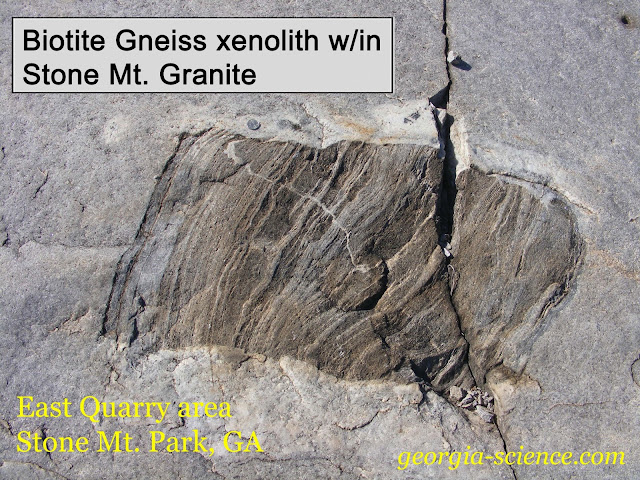Aside from being a nifty word for Scrabble, "Xenolith" is an important component of the concepts of "Inclusions" and "Relative Age Dating".
For a quick review, a Xenolith is a piece of pre-existing rock that "falls" into a body of magma in which the temperatures are not high enough to assimilate the "foreign rock". As the xenolith is an already-solidified piece of rock, it is older than the "host magma" (or lava) into which it falls. Thus, within the xenolith/host rock relationship, the inclusion (xenolith) is always older than the host rock.
My best luck at collecting Xenoliths has been in Kilbournes Hole, New Mexico, and the Eagle Mts., Texas (decades ago) and the backlot of a granite monument cutting business, west of Elberton, GA (below and next post).

In this particular Franklin Mts. outcrop (below), there are at least two sets of Xenoliths, the black basalt/diabase blocks, and the greenish-gray contact-metamorphosed limestone, both of which "fell" into the Proterozoic Red Bluff Granite magma.

This second photo, immediately west and uphill of the above, shows remnants of a larger Castner Marble (limestone) xenolith.
This photo is of a xenolith in the East Quarry area of Stone Mt., Dekalb County, Georgia.
This particular xenolith is from the Elberton Granite. [This image was "squared-off" - using Photoshop - for education purposes.]
In the case of the Mantle, Xenoliths erupted in "volcanic bombs" at Kilbournes Hole, New Mexico, the ultramafic fragments were carried upward by the basaltic magma and erupted in a "Maar Volcano" setting.
Previous posts about the subject:
Kilbournes Hole, NM
What a Geologist Sees - Part 3
What a Geologist Sees - Part 13
What a Geologist Sees - Part 14
Boulder xenolith, Eagle Mts., TX




No comments:
Post a Comment